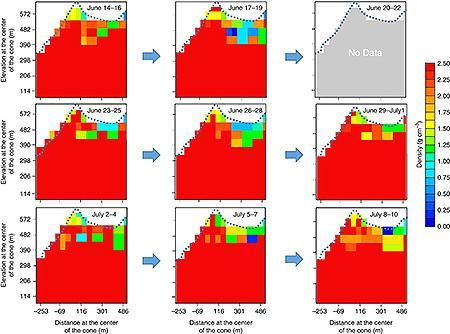Predict an eruption with the news elementary particles "Muon" ... imaging the magma inside the volcanic
Aerial photo of Sakurajima Volcano floating in Kagoshima Bay.
Muon's elementary particles occur when cosmic rays collide with the earth's atmosphere.Muons are using museons to explore volcanoes to transmit objects.[See all images] Predicted eruptions with the elementary particles "Muon" ... Imag an image of a magma inside the volcanic.Muon is everywhere.You may not have noticed, but hundreds of museons are hitting your head each second.This elementary particle is generated when the cosmic ray collides with the earth's atmosphere, is harmless, immediately attenuated, resulting in a light particles.This elementary particle is useful for scientists because it transmits objects like X -rays.In 2017, a huge space was discovered inside the large pyramids of Egypt using Muon.According to a paper published on November 10, 2021 in the British Royal Association Kisei, the musion is also used to map the internal structure of the volcano, which will help to predict dangerous eruptions.。According to Giovanni Leone, a global physicist at Chile's Atakama University and the leading author of the dissertation, how much Muon passes through caves, large spaces, and rocks inside the volcano with magma.It is said that a geological map is created based on the data.Leone has spoken to the New York Times, and added that this technology will eventually become the "ultimate magma detection system" and will be able to track the magma movement before the eruption.

Imagine the inside of the volcano like X -ray shooting
Muon is like a big electron that moves quickly.It has a negative charge, but it weighs 207 times as much as the electron, and moves almost at light.Due to this weight and speed, the musg can pass through a high -density substance, such as a volcanic rock.However, the higher the density of the object, the slower the speed at which the museon passes and the attenuation.Many museons collide with the side of the volcano and pass through the other side.However, if the volcanic density is high, for example, if the gaps in the rock are filled with magma, it cannot be passed.In order to find out how much musicals have passed, a muon detector is installed on the side of the volcano.It is a device that captures the museon that has passed through the volcano and grasps where the unable to pass was exhausted, so that the inside of the volcano was imagined.Some researchers have a muscopter on the helicopter, fly near the side of the volcano, and imagine it.This is similar to the case where the X -ray test of the foot, for example, is performed.The X -ray is irradiated, and if there is nothing to block, a black image is reflected.However, when the bone of the foot absorbs X -rays, the amount of radiation captured by the camera is reduced, and the bone looks white in the image.Volcanity Muography also captures contrast in the same way.When the musg is completely passed, it looks dark on the detector.However, the musicals collide with the high -density part of the volcanic, and when they attenge earlier, they will be bright.In other words, the higher the density of the object, the brighter.The larger the number of museon detectors surrounding the volcano (some are as large as the tennis court), the better images are obtained.According to David Mayhon (not participating in this research), a Muographic researcher at Glasgow University, one detector can only get 2D images."By placing multiple detectors around the object, you can build a rough 3D image," Mayhon tells the New York Times.
Aylin Woodware